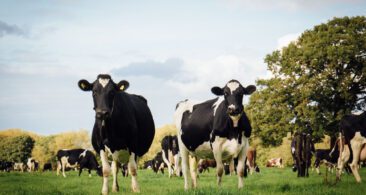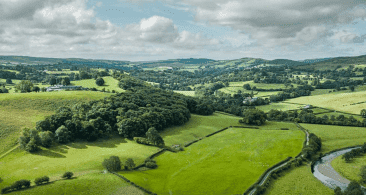Environment
Red meat and dairy produced in the UK are amongst the most sustainable in the world*
* CIEL Report 2020. Full lifecycle emissions of carbon dioxide equivalent per kg of beef, lamb and pork
It is often quoted that livestock emit more greenhouse gas emissions than transport and are a leading cause of climate change. Yet, UK government figures show livestock emit a fraction of those emitted by transport and energy. What's more, these figures are based on estimated averages and do not reflect the whole raft of positive things farmers and their livestock do to support climate action, nature recovery and food security.
Many of us are trying to reduce our environmental impact, but from plastic pollution to carbon emissions, there is a lot to consider with everything we do and buy.
When it comes to the food we eat, producing enough quality food whilst ensuring we can produce enough in the future is important – it’s what makes it sustainable. To do this, UK farmers work hard to get the best out of the resources we have here in the UK, while protecting the environment and landscapes we know and love.
The abundant natural resources from our landscape and temperate climate, means the UK is one of the most sustainable places in the world to produce red meat and dairy.
Transport and energy produce the most emissions, significantly more than livestock
Source: DESNZ 2024 2022 UK Greenhouse Gas Emissions, Final Figures
Carbon dioxide equivalent emissions of seven greenhouse gases from within UK borders.
Carbon
footprint
The carbon footprint of milk produced in the UK is nearly a third lower than the global average. Beef and lamb is almost half the global average.*
Farmers are committed to doing their bit and understand the role they have in helping to cut the UK’s carbon emissions. That’s why they’re focusing on the journey to net zero by 2050.
But sustainability isn’t just about carbon, there are many other things to consider.
* Source: Poore and Nemecek; full lifecycle assessment of global red meat and dairy
Land
Although a lot of our countryside in the UK is farmland (70%), only around 35% of it can actually be used to grow crops like wheat and potatoes. With only around half of that land able to grow fruit and vegetables.
This means 65% of the UK’s agricultural land is grassland and meadows, unable to support food crops, but ideal for grazing animals.
By using this land to graze livestock like cattle and sheep, farmers can produce good-quality, nutritious food, while maintaining the land for nature, providing wildlife with habitats, food sources and shelter.
Water
We may love to moan about our weather, but rainwater makes up around 90% of the water needed to produce red meat and dairy in Britain*, so it’s pretty convenient that we get so much rain.
This means only a small amount of treated or tap water is needed to produce British beef, lamb and milk.
*Source – AHDB Testing the Water report 2013

Rainwater makes up
of the water needed to produce red meat and dairy in Britain*
Grass makes up
Of the feed needed for cows and sheep to prosper

Food
Cattle and sheep play a really important role in sustainable food production because they can turn things like grass and food by-products that we can’t eat, into meat and milk for humans, providing high quality protein alongside a range of nutrients we can’t make ourselves.
It’s important to be clear that everything farmers give livestock to eat is balanced in nutrients and of good quality, but most of it isn’t food we can eat.
For a start, humans get no nourishment from grass (we quite literally don’t have the stomach for it) but cattle and sheep very much do.
Next, there is crop waste, or co-products. These are from wheat, barley, maize, oil-seed rape and crops that do not meet quality standards – like wonky veg, or wheat unsuitable for breadmaking.
And finally, there is food-processing waste, like pea pods, vegetable peelings, sugar beet pulp and even spent grain from beer making. Cheers!
FARMERS WORKING IN HARMONY WITH NATURE
Agriculture is uniquely placed to be part of the solution against climate change. For instance, did you know British farming supports over a million hectares of woodland and forests? Plus, since 2005 farmers have planted over 30,000km of hedgerows – helping biodiversity. English farmers also provide 19,000 hectares of meadows, which provide pollen and nectar sources.
To learn more about what British farmers are doing to be more environmentally friendly, see our farmer stories
Expert opinion
Red meat from Britain is amongst the most sustainable in the world. Farming contributes positively to the management of our unique landscape, supporting sequestration of carbon in soils, grassland, hedgerows and trees. Our systems deliver for the environment and rural communities and provide high quality, nutritious foods for consumers.

Nigel Scollan
Professor
















